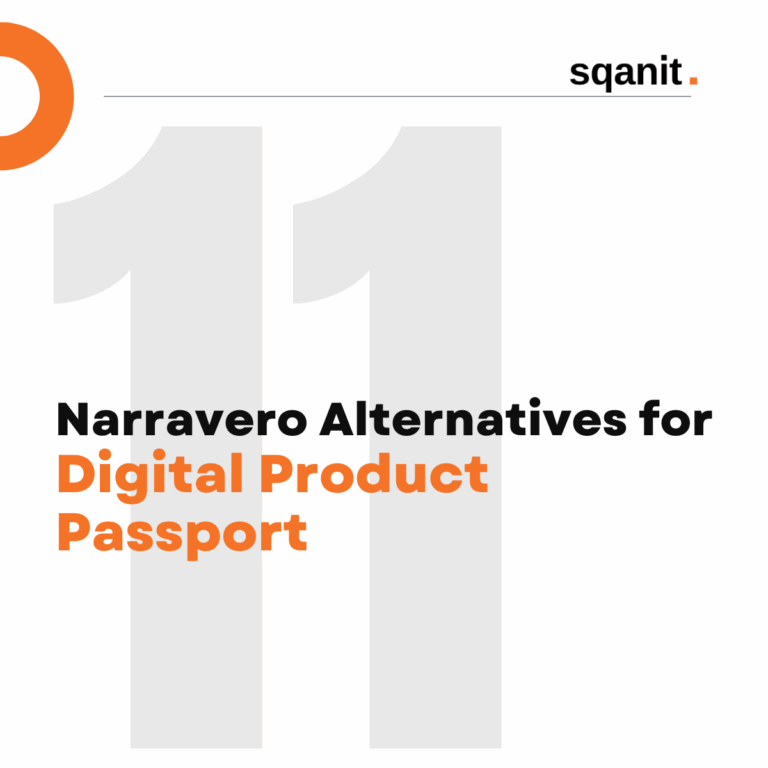Introduction
In the realm of technology, rapid access to information and efficient data sharing are essential for streamlining business processes. For decades, barcodes have been an indispensable tool for product tracking, inventory management, and sales transactions. However, the emergence of QR codes in recent years has introduced innovation and efficiency in this field. So, what are the differences between Barcodes vs QR codes? Which one is more useful, and can we predict which technology will dominate the future? In this article, we’ll explore both technologies and provide a detailed comparison.
What is Barcode?
A barcode is a visual data representation composed of parallel lines and spaces, commonly used for identifying products. These lines are scanned by a barcode reader, converting them into numerical data. Barcodes typically store basic information such as product price, serial number, and stock details, and they are one-dimensional (1D) in nature. The most common example is the striped codes found on products in supermarkets.
When comparing barcodes and QR codes, understanding their types is crucial. Below are the different types of barcodes you can explore:

What is a QR Code?
A QR code, or “Quick Response” code, is a square-shaped, two-dimensional (2D) barcode that can hold significantly more data. This code allows for quick scanning and retrieval of larger datasets within seconds. QR codes can store various types of information, such as product details, website links, and location data, and can be easily scanned using smartphone cameras. They are especially popular for fast information sharing and interaction with mobile devices in the digital world.
Below are the different types of QR Codes you can explore:

Components of a Barcodes vs QR Codes
Componets of a Barcode
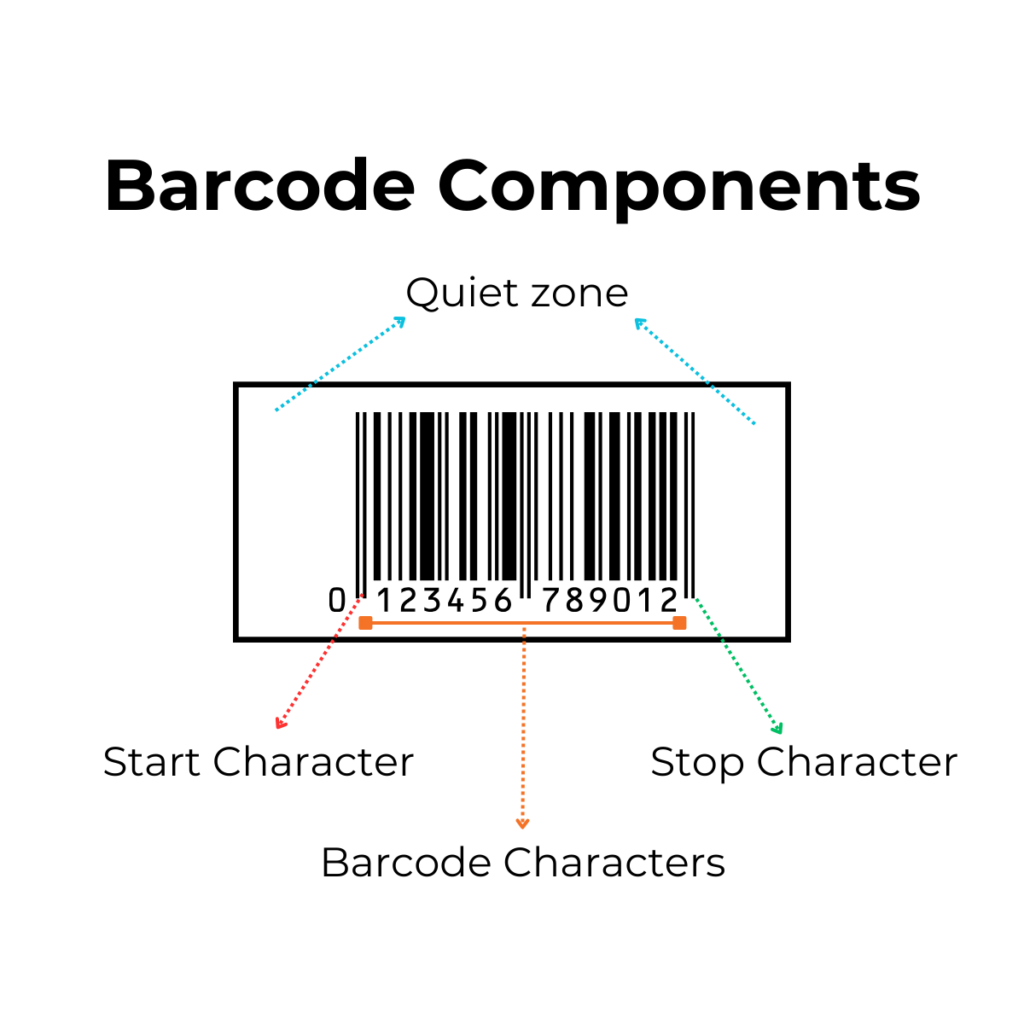
- Lines and Spaces: The fundamental elements of a barcode are the black lines and spaces of varying thickness. Each line and space represents a specific number, which combine to form the product information. The thickness of these lines and the spaces between them can vary depending on the type of barcode.
- Quiet Zone: Surrounding the barcode is a blank area necessary for barcode readers to correctly interpret the code. This zone indicates the start and end points of the barcode and generally does not contain any data.
- Check Digit: This digit, located at the end of the barcode, is used to verify that the barcode has been read correctly. It serves as a security measure for error detection.
- Vertical Scale: The height of the barcode lines is crucial for ensuring that the scanner can read the barcode easily. This height is usually standardized to improve scanner accuracy.
- Numbers (Optional): Some barcodes include numerical data below or beside the lines. These numbers assist humans in interpreting the barcode’s content, serving as a human-readable version of the data stored within.
Components of a QR Code
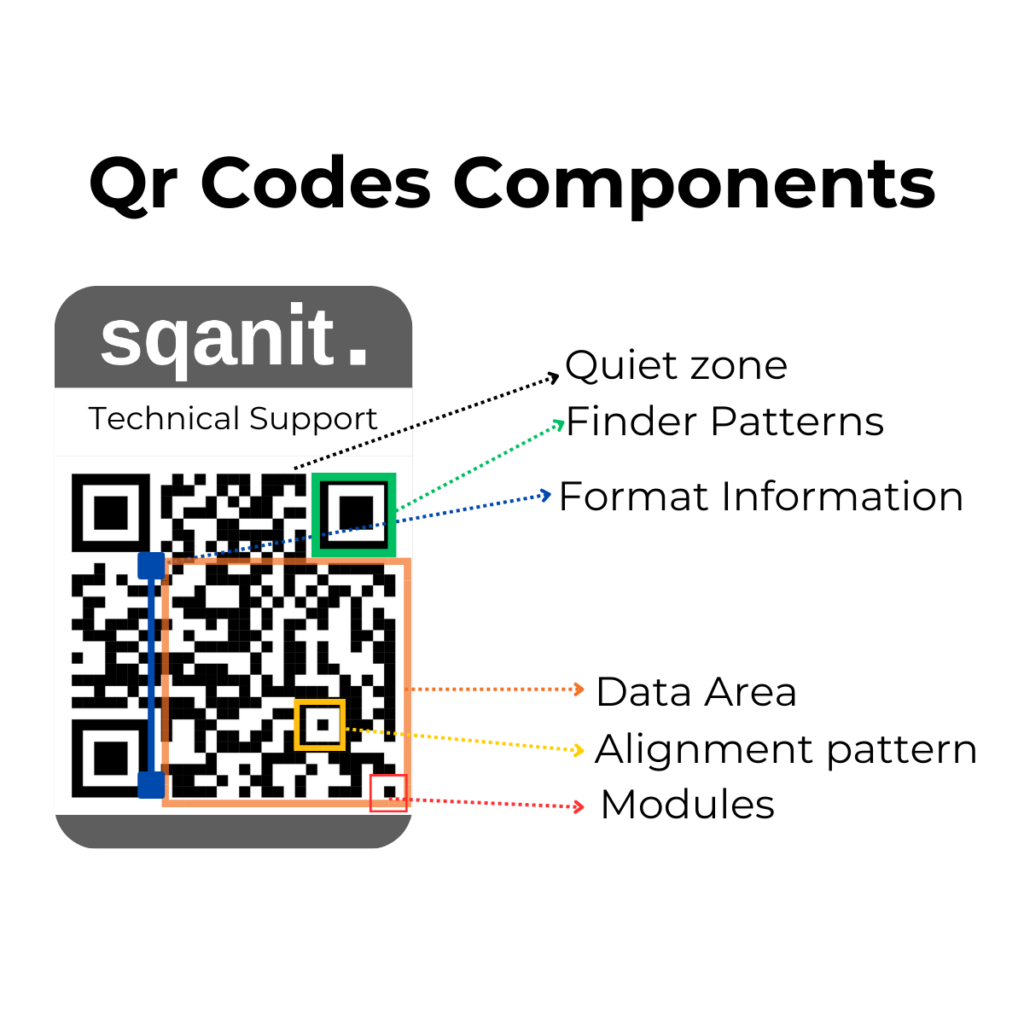
- Squares (Data Modules): A QR code consists of small square modules arranged in black-and-white blocks in a two-dimensional pattern. Each small square represents a binary value (1 or 0), and their arrangement encodes the data in the QR code.
- Position Detection Patterns: The three large squares at the corners of the QR code help scanners and smartphone cameras determine the orientation of the code, ensuring accurate reading.
- Timing Patterns: The small black and white squares along the horizontal and vertical axes of the QR code help define the layout and size of the modules, contributing to the correct decoding of the QR code.
- Error Correction: QR codes incorporate an error correction mechanism, enabling data to be read correctly even if part of the code is damaged during scanning. The error correction level varies depending on the QR code’s complexity and application (e.g., low, medium, high).
- Quiet Zone: Similar to barcodes, QR codes have a blank area surrounding them. This quiet zone helps define the boundaries of the QR code and aids scanners in identifying the code more effectively.
- Data Area: The central part of the QR code is where the encoded data is stored. This data is held within the square modules arranged in a specific pattern and can include various types of information (text, URL, files, etc.).
Advantages and Disadvantages of Barcodes vs QR Codes
Advantages of Barcodes
- Widespread Use: Barcodes have been utilized for many years, making them an accepted standard across nearly every industry. As a result, barcode scanners are ubiquitous and widely used.
- Low Cost: Barcodes are economical in terms of production and usage. They are easy to print on labels, and the scanner devices are generally inexpensive.
- Fast Reading: Being one-dimensional, barcodes can be scanned quickly. This speed is a significant advantage, especially in mass production and point-of-sale operations.
- Simplicity: Barcodes provide a straightforward system for carrying specific and limited amounts of information, making them ideal for simple tasks like product tracking.
Disadvantages of Barcodes
- Limited Data Capacity: Barcodes can only hold a limited amount of data, typically just numbers or small amounts of text. This can be insufficient for more complex data needs.
- Sensitivity to Damage: Barcodes can become difficult to scan if they are scratched or damaged, leading to potential data loss.
- One-Dimensional Structure: Barcodes contain data only on a horizontal plane, which limits their data density and prevents them from carrying larger amounts of information.
- Need for Correct Reading Angle: For accurate reading, barcodes require the scanner to be at a specific angle and distance.
Advantages of QR Codes
- High Data Capacity: QR codes, with their two-dimensional structure, can store significantly more information than barcodes. They can hold various types of data, including text, URLs, phone numbers, and files.
- Easy Access and Scanning: QR codes can be easily scanned using the cameras of smartphones and tablets, eliminating the need for a special reader, thereby enhancing usability.
- Error Correction Capability: QR codes can still be scanned accurately even if they are partially damaged, thanks to their error correction algorithms, which makes them robust.
- Versatility: QR codes can be used for various purposes in the digital world, such as directing users to websites, downloading apps, and sharing locations, making them ideal for marketing, customer experience, and data sharing.
- Omnidirectional Scanning: QR codes can be scanned correctly regardless of the scanning angle, making it easier for users to scan.
Disadvantages of QR Codes
- More Complex and Larger Structure: Due to their ability to store more data, QR codes are typically more complex and larger than barcodes. This can sometimes be a disadvantage in terms of aesthetics and space.
- Print Quality Sensitivity: For QR codes to be scanned correctly, they need to be printed at a high resolution. Low-resolution prints can lead to scanning issues.
- Special Device Requirements (Past): Initially, QR codes could only be scanned with specific devices. Although this issue has been mostly resolved today, some devices may still have limited support.
- Slower Reading Time: Due to the higher amount of data they contain, QR codes can take slightly longer to scan compared to barcodes. While this difference is usually minimal, it can be noticeable in systems processing large amounts of data.
Barcodes vs QR Codes: Which is Better?
The answer to this question depends entirely on your usage and needs. Barcodes vs QR Codes offer different features for data storage and sharing, meaning both technologies have their strengths and weaknesses.
- Barcodes:
- Ideal for low-cost, simple information tasks.
- Effective in areas requiring limited data capacity, such as product tracking, inventory management, and point-of-sale operations.
- As a standardized technology used for many years, they are widely accepted across nearly every industry.
- QR Codes:
- A versatile alternative that meets modern needs with higher data capacity.
- Easily scannable by smartphones, resilient to damage, and capable of carrying complex data.
- Popular in the digital world, offering significant advantages in marketing, quick access, web redirections, and interactions with mobile devices.
Conclusion: If your needs include simple product tracking, pricing, and inventory management, barcodes may suffice. However, for extensive data storage, flexibility, and digital integration, QR codes are the better choice. Considering technological evolution, QR codes are increasingly being utilized and are expected to become more prevalent in the future.
Mandatory Transition from Barcodes to QR Codes by 2027
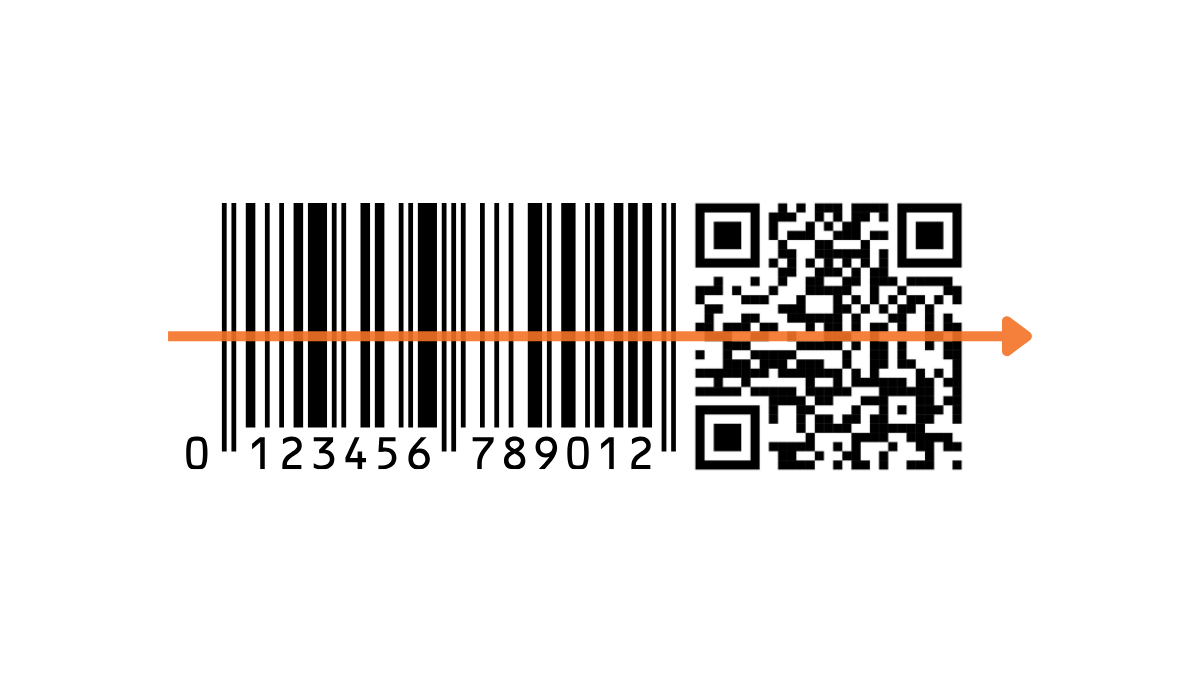
With the global digitalization of commerce and the rising need for data sharing, QR codes, a more advanced technology, are replacing barcodes. According to a global industry endorsement released by GS1 in 2024, the transition from barcodes to QR codes will become mandatory by 2027. This requirement aims to enhance transparency, security, and traceability in the supply chain by allowing products to contain more data.
QR codes will provide users with detailed information quickly and easily—not just about the price or stock status of a product but also about its origin, components, and expiration date. This transformation will offer a more reliable and informative shopping experience for both manufacturers and consumers.
The mandatory transition, effective from 2027, is viewed as a significant innovation, especially in the retail, logistics, and healthcare sectors. Businesses are advised to prepare for this change now.
sqanit´s Use of QR Codes and Preparation for DPP Role of QR Code
sqanit offers an innovative platform that digitizes service and support processes related to physical products. QR code technology is a crucial tool in this digitalization process. With sqanit’s QR code solutions, users can quickly and easily access information and support services related to their products. By scanning the QR code, users can instantly access technical documents, user manuals, and maintenance recommendations. They can also leverage AI-powered self-service paths or live support options to resolve product-related issues.
Compatibility with Digital Product Passport (DPP)

sqanit provides a Digital Product Passport (DPP) solution that enables companies to organize and share all lifecycle data related to their products, in line with the European Union’s Circular Economy Action Plan and Ecodesign for Sustainable Products Regulation (ESPR). This solution integrates with QR code technology, allowing easy access to production, usage, recycling, and sustainability information of products. All critical product information is accessible via a single QR code, ensuring transparency and traceability throughout the supply chain.
If you would like to learn more about Digital Product Passports and explore the opportunities this innovative solution offers, please fill out this form, and we will get in touch with you.
sqanit’s Preparation Process and Capabilities
The Digital Product Passport solution from sqanit helps companies maximize the lifecycle value of their products and comply with regulations. The transition from barcodes to QR codes, becoming mandatory by 2027, can be seamlessly managed through sqanit’s platform. The features offered by sqanit include:
- AI-Powered Self-Service Options: AI-driven guidance providing quick solutions to product-related issues via QR codes.
- File Management: Easy access to product manuals, documents, and files by scanning the QR code.
- Service Communication: Direct access to chat and ticketing systems through QR code scans for instant support.
- AR-Supported Remote Assistance: AR-enabled remote assistance through QR codes, allowing on-site resolution of technical issues.
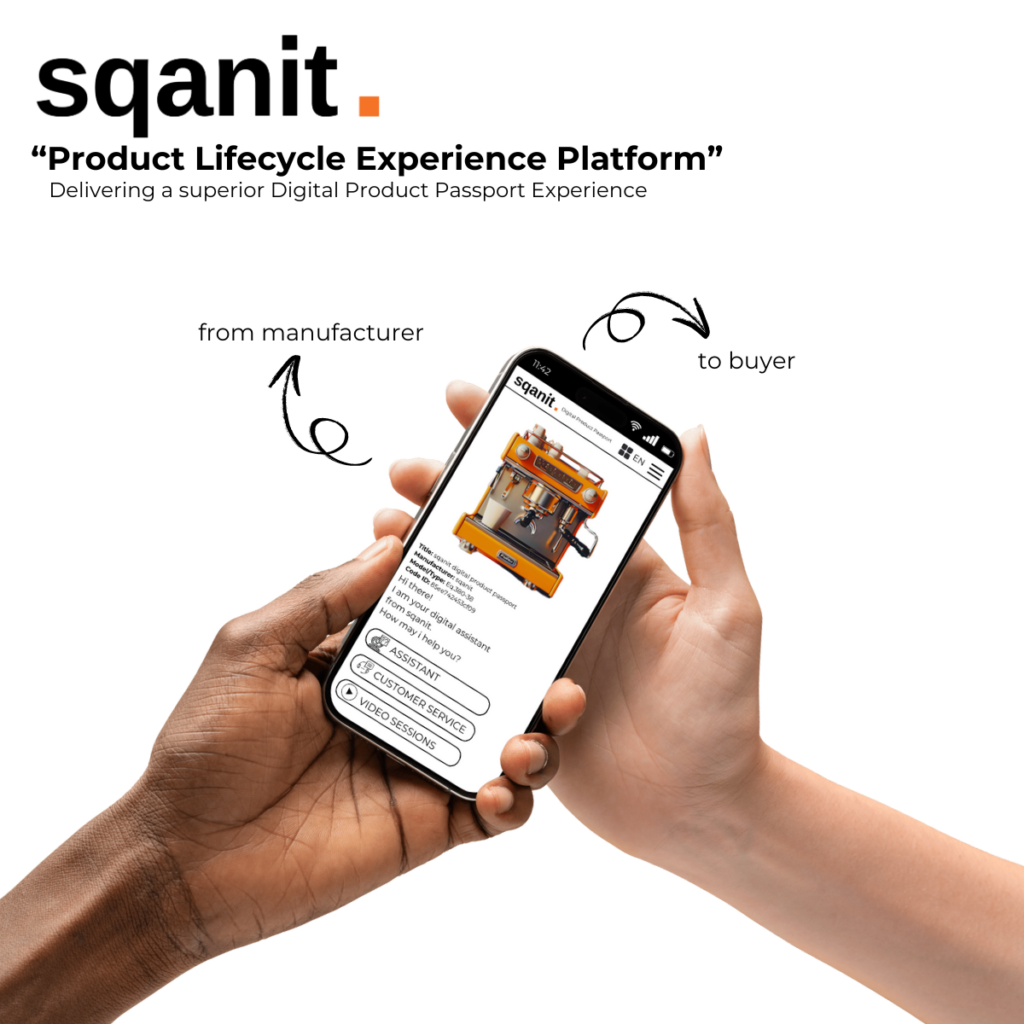
Compliance with Requirements
sqanit’s platform provides all the technological infrastructure that companies need for the future mandatory Digital Product Passport and QR code integration. It ensures transparency and data sharing at every stage of the product lifecycle, facilitating companies to achieve their sustainability goals and comply with regulations.
If you would like to learn more about our Digital Product Passport (DPP) solutions and the possibilities offered by the sqanit platform, our team would be delighted to assist you. Contact us to maximize the lifecycle of your products, achieve your sustainability targets, and ensure compliance with future regulations.
Contact us at: sales@sqanit.com
We are here to answer your questions and provide you with tailored solutions!
This article is for informational purposes only and does not constitute legal advice. As sqanit, no liability is accepted for any actions taken based on the information provided herein. Readers are encouraged to consult with qualified professionals for specific advice tailored to their individual circumstances.



